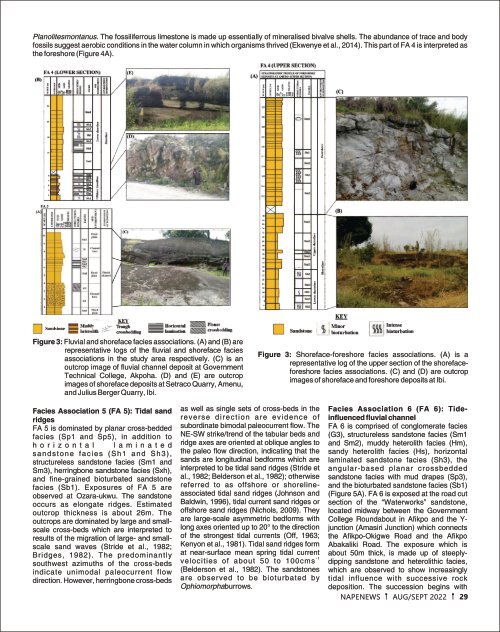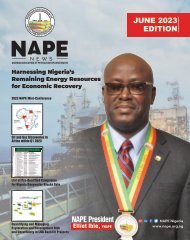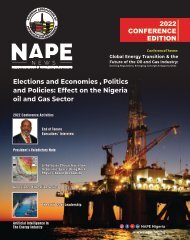You also want an ePaper? Increase the reach of your titles
YUMPU automatically turns print PDFs into web optimized ePapers that Google loves.
Planolitesmontanus. The fossiliferrous limestone is made up essentially of mineralised bivalve shells. The abundance of trace and body<br />
fossils suggest aerobic conditions in the water column in which organisms thrived (Ekwenye et al., 2014). This part of FA 4 is interpreted as<br />
the foreshore (Figure 4A).<br />
Figure 3: Fluvial and shoreface facies associations. (A) and (B) are<br />
representative logs of the fluvial and shoreface facies<br />
associations in the study area respectively. (C) is an<br />
outcrop image of fluvial channel deposit at Government<br />
Technical College, Akpoha. (D) and (E) are outcrop<br />
images of shoreface deposits at Setraco Quarry, Amenu,<br />
and Julius Berger Quarry, Ibi.<br />
Figure 3: Shoreface-foreshore facies associations. (A) is a<br />
representative log of the upper section of the shorefaceforeshore<br />
facies associations. (C) and (D) are outcrop<br />
images of shoreface and foreshore deposits at Ibi.<br />
Facies Association 5 (FA 5): Tidal sand<br />
ridges<br />
FA 5 is dominated by planar cross-bedded<br />
facies (Sp1 and Sp5), in addition to<br />
h o r i z o n t a l l a m i n a t e d<br />
s a n d s t o n e f a c i e s ( S h 1 a n d S h 3 ) ,<br />
structureless sandstone facies (Sm1 and<br />
Sm3), herringbone sandstone facies (Sxh),<br />
and fine-grained bioturbated sandstone<br />
facies (Sb1). Exposures of FA 5 are<br />
observed at Ozara-ukwu. The sandstone<br />
occurs as elongate ridges. Estimated<br />
outcrop thickness is about 26m. The<br />
outcrops are dominated by large and smallscale<br />
cross-beds which are interpreted to<br />
results of the migration of large- and smallscale<br />
sand waves (Stride et al., 1982;<br />
Bridges, 1982). The predominantly<br />
southwest azimuths of the cross-beds<br />
indicate unimodal paleocurrent flow<br />
direction. However, herringbone cross-beds<br />
as well as single sets of cross-beds in the<br />
reverse direction are evidence of<br />
subordinate bimodal paleocurrent flow. The<br />
NE-SW strike/trend of the tabular beds and<br />
ridge axes are oriented at oblique angles to<br />
the paleo flow direction, indicating that the<br />
sands are longitudinal bedforms which are<br />
interpreted to be tidal sand ridges (Stride et<br />
al., 1982; Belderson et al., 1982); otherwise<br />
referred to as offshore or shorelineassociated<br />
tidal sand ridges (Johnson and<br />
Baldwin, 1996), tidal current sand ridges or<br />
offshore sand ridges (Nichols, 2009). They<br />
are large-scale asymmetric bedforms with<br />
long axes oriented up to 20° to the direction<br />
of the strongest tidal currents (Off, 1963;<br />
Kenyon et al., 1981). Tidal sand ridges form<br />
at near-surface mean spring tidal current<br />
- 1<br />
velocities of about 50 to 100cms<br />
(Belderson et al., 1982). The sandstones<br />
are observed to be bioturbated by<br />
Ophiomorphaburrows.<br />
Facies Association 6 (FA 6): Tideinfluenced<br />
fluvial channel<br />
FA 6 is comprised of conglomerate facies<br />
(G3), structureless sandstone facies (Sm1<br />
and Sm2), muddy heterolith facies (Hm),<br />
sandy heterolith facies (Hs), horizontal<br />
laminated sandstone facies (Sh3), the<br />
angular-based planar crossbedded<br />
sandstone facies with mud drapes (Sp3),<br />
and the bioturbated sandstone facies (Sb1)<br />
(Figure 5A). FA 6 is exposed at the road cut<br />
section of the “Waterworks” sandstone,<br />
located midway between the Government<br />
College Roundabout in Afikpo and the Y-<br />
junction (Amasiri Junction) which connects<br />
the Afikpo-Okigwe Road and the Afikpo<br />
Abakaliki Road. The exposure which is<br />
about 50m thick, is made up of steeplydipping<br />
sandstone and heterolithic facies,<br />
which are observed to show increasingly<br />
tidal influence with successive rock<br />
deposition. The succession begins with<br />
NAPENEWS AUG/SEPT <strong>2022</strong> 29










